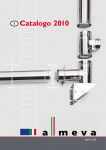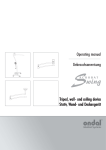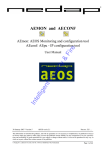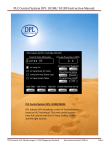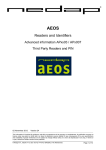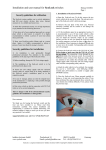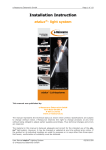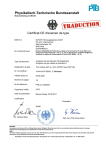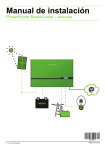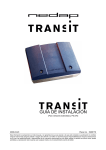Download 3.3 Test Report [17 September 2003] PDF
Transcript
Physikalisch-Technische Bundesanstalt Braunschweig und Berlin Prüfbericht Test report Gegenstand: Object: Hersteller: Manufacturer: Typ: Type: Gerätenummer: Serial number: Auftraggeber: Applicant: Anzahl der Seiten: Type testing of a voting machine for elections/referenda in Ireland in accordance with the request of 2003-03-05 and confirmation by PTB of 2003-03-20 N.V. Nederlandsche Apparatenfabriek NEDAP Parallelweg 2 G / P.O.Box 105 7140 AC GROENLO The Netherlands Voting machine: Powervote - Integrated Election System ESI2, Hardware version (Main) 03.00, (Connection) 01.00, (Display) 03.00 Software version (Main) 02.02, (Connection) 01.05, (Display) 02.01 R3D01028 NNE00010 (ID-number of the prototype) (ID-number of the Programming Unit) Department of the Environment and Local Government, Franchise Section, Custom House Dublin I Ireland 25 Number of pages: Geschäftszeichen: PTB-8.33-PA-17/03a Reference No.: Datum der Prüfung: 2003-03-20 to 2003-09-04 Date of test: Im Auftrag Berlin, 2003-09-17 By order Bearbeiter: Examiner: 393 03 c Siegel Seal Dr. Bronder Sachse Prüfberichte ohne Unterschrift und Siegel haben keine Gültigkeit. Dieser Prüfbericht darf nur unverändert weiterverbreitet werden. Auszüge bedürfen der Genehmigung der Physikalisch-Technischen Bundesanstalt. Test reports without signature and seal are not valid. This test report may not reproduced other than in full. Extracts may be taken only with the permission of the Physikalisch-Technische Bundesanstalt Physikalisch-Technische Bundesanstalt Seite 2 zum Prüfbericht vom 2003-09-17 , Geschäftszeichen: PTB-8.33-PA-17/03a Page 2 of test report of 2003-09-17, Reference No.: PTB-8.33-PA-17/03a Contents Page 1 General remarks .....................................................................................................3 2 Description of the voting machine ...........................................................................3 2.1 Identification of every voting machine and software .......................................3 2.2 Components of the system .............................................................................4 2.3 Operation mode ..............................................................................................4 2.4 Voting machine accessories ...........................................................................4 2.5 Conditions during storage and transport .........................................................4 2.6 View of the voting machine .............................................................................4 2.7 Technical data ................................................................................................4 3 Tests and results.....................................................................................................5 3.1 Test criteria .....................................................................................................5 3.2 Scope of test...................................................................................................5 3.3 Requirements and test results ........................................................................5 4 Conclusions...........................................................................................................21 4.1 Functional Tests of Hardware and Software .................................................21 4.2 Software........................................................................................................21 4.3 Documentation..............................................................................................21 4.4 Statement concerning retrofitted voting machines ........................................21 5 APPENDIX: Lists of voting machine documentations ...........................................22 Enclosures Encl. 1: Encl. 2: SW-Test Report - Voting machine ESI1, dated 2003-09-17 - Software for elections in Ireland – Software Requirements for Voting Machines for Use at Elections in Ireland, dated 2003-03-18 Reference PTB-Test-Report No.: PTB-8.33 - 130/02, dated 2002-08-23 PTB-Test-Report No.: PTB-8.33 - 73/01, dated 2002-01-29 Physikalisch-Technische Bundesanstalt Seite 3 zum Prüfbericht vom 2003-09-17 , Geschäftszeichen: PTB-8.33-PA-17/03a Page 3 of test report of 2003-09-17, Reference No.: PTB-8.33-PA-17/03a 1 General remarks By letter of March 3, 2003 the PTB received the order to test the microprocessor-controlled voting machine ESI2_1 of the NEDAP N.V. company with the updated hardware version 3.00 and software version 2.00 in accordance with "Functional specification - Nedap voting system ESI2 - Powervote" and the new "Requirements for voting machines for use at elections in Ireland DVREC-2”, dated March 5, 2003. The order for the test does not cover paragraphs 1.5, 4 (testing the voting machine against the Irish statutory requirements), 9.4, 11 (testing environmental conditions of the voting machine) and paragraph 12 (safety and health requirements for the manual handling of the voting machine), nor does it include the hardware tests of paragraphs 8.2, 8.3, 8.4, 10.2 and 10.3, which refer to paragraph 11 of the App. Part 1 to the “Requirements for voting machines for use at elections in Ireland DVREC-2”. After the order for the test had been placed, some corrections were made in the Hardware and in the software of the voting machine’s main control program. The test performed by the PTB is based on the software release versions 02.02, 01.05 and 2.01 of the main control, connection board and display board programs. The last version of the machine and the corrected main control arrived at PTB on June 5, 2003. The last documents arrived at PTB on Sep. 4, 2003. The documents made available by the NEDAP company are listed in the Appendix to this Test Report. For the sake of completeness, all paragraphs with requirements of the DVREC-2 are listed in section 3.3 of this Test Report and in enclosure 2 concerning the software requirements. At present, the prototype of the voting machine ESI2 and the programming/reading unit (PRU) are beeing kept at the PTB. The first prototype N7D00003 of the voting machine ESI1 will be given back to the NEDAP company. 2 Description of the voting machine 2.1 Identification of every voting machine and software Type, version and ID numbers of the hardware: Voting machine (VM) with control unit (CU): type: ESI2 version: 03.00 ID: YMDxxxxx incl. one connection board version 01.00 and five display boards version 03.00 Programming/reading units (PRU): type: ESI1 version: 03.00 ID: YMExxxxx Primary ballot and backup modules: type: ESI2 ID: YMCxxxxx Description of the different identifier numbers (ID) YMTxxxxx: Y = year of production (A=1988, B=1989,..., K=1998, L=1999,..., N=2001) M = month of production (1=January,...., O=October,.N=November, D=December) T = system component identifier (C= ballot module of ESI2, D= voting machine ESI2, E= P/R unit of ESI2) xxxxx = five numerical characters forming the serial number of every system component Physikalisch-Technische Bundesanstalt Seite 4 zum Prüfbericht vom 2003-09-17 , Geschäftszeichen: PTB-8.33-PA-17/03a Page 4 of test report of 2003-09-17, Reference No.: PTB-8.33-PA-17/03a Version numbers and (ID) checksums of the stored programs: Main control (Main board memory): Pack: ESI2_1 Checksum even: Checksum odd: 00EA28AA 010C794E Version: 02.02 ID: Checksums (hexadecimal) (hexadecimal) Connection (communication) control: stored on the memory of the conn. board Checksum: Version: 01.05 ID: Checksum (hexadecimal) 00004237 Display control: stored on each memory of five display boards Checksum: 0000D9A8 Version: 02.01 ID: Checksum (hexadecimal) 2.2 Components of the system See description in section 1.3 of "Functional Specification - Nedap Voting System ESI2 - Powervote". 2.3 Operation mode See description in section 2 of "Functional Specification - Nedap Voting System ESI2 - Powervote". 2.4 Voting machine accessories See description in sections 1.4 and 1.5 of "Functional Specification - Nedap Voting System ESI2 Powervote". 2.5 Conditions during storage and transport See requirements in paragraph 11.2 of Appendix Part 1 to "Requirements for voting machines for use at elections in Ireland DVREC-2". 2.6 View of the voting machine See pictures and description on pages 4, 5 and 10 of "Voting machine operator´s guide". Special descriptions are given in section 1.3 of "Functional Specification - Nedap Voting System ESI2 Powervote". 2.7 Technical data See description in section 1.8 of "Functional Specification - Nedap Voting System ESI2 - Powervote". Physikalisch-Technische Bundesanstalt Seite 5 zum Prüfbericht vom 2003-09-17 , Geschäftszeichen: PTB-8.33-PA-17/03a Page 5 of test report of 2003-09-17, Reference No.: PTB-8.33-PA-17/03a 3 Tests and results 3.1 Test criteria Test requirements and criteria are listed in the Appendix Part 1 "Conditions for voting machines" of "Requirements for voting machines for use at elections in Ireland DVREC-2" and in the "Functional specification - Nedap voting system ESI2 - Powervote". Quality criteria for the software are listed in enclosure 2. 3.2 Scope of test The test covers inspection of the voting machine, examination of its construction and technical design, test of the voting machine accessories and examination of the documentation submitted by the manufacturer. Some functions and operating modes of the voting machine were also tested. The software of the voting machine was tested by inspection of the source codes and of the relevant documentation. Moreover, static analyses and dynamic tests are carried out with the aid of suitable software tools. 3.3 Requirements and test results The following list includes all requirements of the Appendix Part 1 "Conditions for voting machines" of "Requirements for voting machines for use at elections in Ireland DVREC-2" and contains some notes which will help to understand the test results. The tests of the PTB do not include the paragraphs 1.5, 4, 9.4, 11 and 12 of the Appendix Part 1 to DVREC-2. Details of the software test results are described in the SW-test report (see enclosure 1). Requirement (Appendix Part 1 of "DVREC-2") and notes No. Result C o nd i t ion s f o r vo t in g mac h in es 1 (1) General 1.1 The requirements for voting machines contained in the Functional Specification document (version 1.9 of May 28, 2003), the electoral law and this Appendix are mandatory. - The agreement of the prototype of the voting machine with the details of the functional specification document was tested exemplarily for the different elections and the referendum. No deviations were found. - Requirements defined in the electoral law (paragraphs 1,5 and 4) were not examined. - The agreement with the requirements, defined in the (next) paragraphs in Appendix of "DVREC-2", is described in the following sections. OK Physikalisch-Technische Bundesanstalt Seite 6 zum Prüfbericht vom 2003-09-17 , Geschäftszeichen: PTB-8.33-PA-17/03a Page 6 of test report of 2003-09-17, Reference No.: PTB-8.33-PA-17/03a (2) 1.2 The voting machine shall be constructed in line with the current general state of technology and be designed in accordance with recognised rules of technology applied to systems used in the machine. OK *) Construction: The construction of the voting machine is in line with the current general state of technology. The main processor used is based on the Motorola M68000 series (16 bit data bus and 32 bit adress bus), here in the high-speed CMOS version M68HC000 (very fast and lower current consumption). The storage circuits used for the main control program are two EPROM of the 27C512 type (512 kbit = 64 kByte memory capacitance). For the storage of the error and event history and of the last vote in the case of power loss, an EEPROM X2864A with a capacitance of 64 kbit = 8kByte is used. Two Flash EEPROM (electrical erasable PROM) 28F010 (capacitance: 1Mbit = 128 kByte) per ballot module are used for the storage of the initial data and the votes cast in the primary ballot module and in the backup module. All other circuits used are fast standard CMOS circuits with good device features. Technical design: The technical design of the voting machine and of the systems used in the machine is in accordance with recognised rules of technology; in particular all circuits used are standardized circuits. The electronic circuits and elements are mainly designed in the SMD- (source mounted device) technology. The dimensions of the printed circuit boards (PCB´s) are not standardized. This ensures that it is difficult for unauthorised persons to manipulate the hardware (for instance a ballot module). Communication between the main processor and the display and communication boards is based on an I2C bus system, that is to say, the amount of necessary cable conductions is reduced and the information exchange is less susceptible to external influences. The voting machine is not equipped with connections via which the control programs stored could be supplemented or changed. *) For construction and design of the software, see Encl. 1. (3) 1.3 The voting machine shall be designed in such a way that any unauthorised alterations of a technical nature will come to notice. The type, the version number and the individual identifier (serial) number (ID) of the voting machine and of the programming/reading unit are given on a type plate. Every ballot module is identified by the individual ID-number. The version numbers of the voting machine, the connection (communication) board and the five display boards and the ID-numbers of the voting machine and the installed ballot module can be displayed on, and printed out by, the voting machine. This enables the polling staff to compare the type, the version numbers and the individual ID-numbers with the values given by the manufacturer in documentation (user manual) or e.g. listed in an authorised certificate. The compartment for holding the primary ballot module is provided with a lock and a covering flap with holes for insertion of a seal. The primary ballot module must be programmed for the poll(s) and the correctness of programming must be tested. After that, the voting machine must be sealed with an official seal at the right side of the case and transported to the polling stations. In addition there shall be two physical seals on the cover of the electronics unit to prevent the exchange or interference with program chips. Before the poll, the presiding officer of the polling station must check whether the seals are still intact. OK Physikalisch-Technische Bundesanstalt Seite 7 zum Prüfbericht vom 2003-09-17 , Geschäftszeichen: PTB-8.33-PA-17/03a Page 7 of test report of 2003-09-17, Reference No.: PTB-8.33-PA-17/03a (4) 1.4 In the case of a processor–controlled machine, any alteration of the installed software by an unauthorised person will be detected. OK The program version numbers and checksums of the installed software for the main control board, the connection (communication) board and the five display boards can be displayed on, and printed out by, the voting machine. This enables the polling staff to compare these program version numbers and checksums with the values given by the manufacturer in documentation (user manual) or e.g. listed in an authorised certificate. (5) 1.5 The relevant statutory procedures for the preparation of a voting machine for a not tested poll, use at a poll and at the close of a poll shall be capable of being performed by the voting machine. The word “poll” is deemed to include more than 1 poll (maximum 5) held simultaneously. 2 (6) General conditions concerning the provision of information by the voting machine 2.1 The information provided by the voting machine to the user (polling staff and voter) must be relevant and clear. OK The operating elements and identifications are neatly arranged on the voting machine. They are to a large extent self-explanatory and have been limited to what is necessary. The detailed description of the information given by the voting machine to the users (polling staff and voter) is contained in the functional specification document. (7) 2.2 The voting machine must provide the user (polling staff and voter) with information, either on the display screen on the voting machine or on the Control Unit or otherwise, on the steps that the user must or can take in sequence using the voting machine and about the functions the voting machine is carrying out pursuant to the actions taken by the user, subject to the condition that the candidate or referendum choices recorded or vote(s) cast on the machine by the voter cannot be related to that voter either at the time of voting or subsequently. OK The sequence to be followed during polling is signalled to the voter and to the polling staff by suitable optical displays and acoustic signals. Operation of the functions of the Control Unit, which release and block the voting machine during polling, as well as operation of the voting machine prior to and after polling are described in the user manual: “voting machine handbook”. The detailed description of the information given by the voting machine to the users (polling staff and voter) is contained in the “functional specification” document and was checked by functional tests and software-tests (Encl. 1). The voter cannot be identified by the voting machine, and the voting machine does not have elements with which data of the voter can be input or stored. (8) 2.3 The voting machine must provide a statement before polling commences and at close of poll listing the candidates on the ballot paper, the total number of activations of the voting machine, the number of votes cast, if any, including any null votes in the case of multiple polls, on the machine, number of deactivations of the voting machine where a voter does not press the “CAST VOTE(S)” button and other relevant details of the voting machine and the poll(s) concerned. The detailed description of the information given by the voting machine to the users (polling staff and voter) is contained in the functional specification document and was checked by functional tests and software tests (Encl. 1). OK Physikalisch-Technische Bundesanstalt Seite 8 zum Prüfbericht vom 2003-09-17 , Geschäftszeichen: PTB-8.33-PA-17/03a Page 8 of test report of 2003-09-17, Reference No.: PTB-8.33-PA-17/03a 3 (9) Installation of a ballot module 3.1 Following the insertion of a programmed ballot module into the voting machine, the voting machine shall carry out the following functions in sequence: - check to ensure that the voting machine is functioning correctly as defined in the Functional Specification; OK This requirement was checked by functional tests and software tests (Encl. 1). - and display and/or print the contents of the memory of the primary ballot module. (10) OK This requirement was checked by functional tests and software tests (Encl. 1). (11) 3.2 The insertion of a primary ballot module shall be controlled by means of a physical key. OK The primary ballot module can be inserted and removed only by means of a red marked "module switch key" on the backside of the voting machine This key has two functions: First, the mechanical locking of the covering flap (with holes for insertion of a seal) over the primary ballot module slot and, secondly the connection to the power supply. This requirement was checked by functional tests only. (12) The compartment for holding the primary ballot module shall be provided with a lock and with a covering flap with holes for insertion of a seal. OK See note on (11) This requirement was checked by functional tests only. (13) The machine can only be activated for voting if a module has been installed and the lock on the ballot module slot is in the closed position. OK See note on (11). If no primary ballot module has been provided, the voting machine starts with an error message and voting is impossible. This requirement was checked by functional tests and software tests (Encl. 1). (14) 3.3 A back-up module shall be installed and retained in the voting machine in accordance with the Functional Specification. OK If no back-up module has been provided, the voting machine starts with an error message and voting is impossible. This requirement was checked by functional tests and software tests (Encl. 1). 4 (15) Displaying ballot paper The ballot paper displayed on the voting machine must comply with the Electoral Act, 1992, the Electoral (Amendment) Act, 2001 or relevant Ministerial Order under section 48 of the Act of 2001 and must be verified by statements printed from the voting machine before voting commences and at close of poll. not tested Physikalisch-Technische Bundesanstalt Seite 9 zum Prüfbericht vom 2003-09-17 , Geschäftszeichen: PTB-8.33-PA-17/03a Page 9 of test report of 2003-09-17, Reference No.: PTB-8.33-PA-17/03a 5 Pr ep ara t io n bef or e t h e p o l l 5.1 A voting machine can only be used for a poll, after it has carried out or supported the following steps in sequence: - demonstrated, by way of a printed statement or on the display screen, that no votes are recorded; (16) OK By reading the display or by printing out the module contents the polling staff can check that no votes are stored in the primary ballot module. Prior to the election, in order to document that the ballot module is empty, print-out of a (zero) polling result can be initiated via the “Functions” menu. - and checked that the voting machine is functioning correctly in accordance with the Functional Specification (Sections 2 and 8). (17) OK After a primary ballot module has been inserted and the red module switch key turned (on the backside of the voting machine) in the operating position, the voting machine executes different self tests described in the functional specification. If an error occurs, an error message is displayed and voting is impossible. (18) (19) 5.2 Votes shall only be recorded if the key referred to in 3.2. is inserted in the Control Unit. The polling staff can release the voting machine for voting only if a red-marked "function switch" key is inserted in the control unit and if this key is in the operating position. This requirement was checked by functional tests only. Withdrawal of the key from the Control Unit will switch the voting machine to standby and prevent votes from being recorded. OK OK The "function switch" key is mechanically locked in the operating position. It can only be withdrawn when it is turned into the standby position. In this position voting is impossible. This requirement was checked by functional tests only. 6 (20) The poll 6.1 The voting machine shall not record votes, unless it has been activated. OK See notes on (11) to (14) and (17) to (19) 6.2 For the recording of votes, the voting machine shall carry out or support the following steps in sequence: (21) - the voting machine is activated for each voter by the presiding officer or a person authorised by the officer- each activation will be recorded by the voting machine; Only the polling staff is able to activate the voting machine for the voter by pressing the assigned button (i.e. the button assigned to the election(s) the voter is entitled to vote for) on the control unit. OK Physikalisch-Technische Bundesanstalt Seite 10 zum Prüfbericht vom 2003-09-17 , Geschäftszeichen: PTB-8.33-PA-17/03a Page 10 of test report of 2003-09-17, Reference No.: PTB-8.33-PA-17/03a (22) - LED on top of each ballot paper column highlights ballot paper(s) on which a voter is entitled to vote; OK This requirement was checked by functional tests and software tests (Encl. 1). (23) - LED displays to the right of the ballot paper shall display the marks “-- --“ on open ballot paper(s); OK This requirement was checked by functional tests and software tests (Encl. 1). (24) - LED-displays opposite each candidate’s details or referendum choice will display the preferences recorded on each ballot paper presented on voting machine; in the case of a referendum, the “X” shall be in the left hand position of the LED; OK This requirement was checked by functional tests and software tests (Encl. 1). (25) - when a preference is recorded, details will be displayed on the bottom line of the voting machine display screen; OK This requirement was checked by functional tests and software tests (Encl. 1). (26) - provision for changing a preference for a candidate or referendum choice will be provided by pressing the button a second time beside that candidate’s details or referendum choice; OK This requirement was checked by functional tests and software tests (Encl. 1). (27) - a voter will be able to cast his or her vote when at least one preference has been recorded on a ballot paper and, where there is more than 1 ballot paper and no preference(s) is/are recorded on the second or other remaining ballot papers, following a reminder displayed on the display screen; OK This requirement was checked by functional tests and software tests (Encl. 1). (28) - a vote will be recorded, including a null vote where applicable, in the voting memory of the voting machine, following the pressing of the “ CAST VOTE(S)” button. OK This requirement was checked by functional tests and software tests (Encl. 1). (29) This process shall include a check that the recording of the vote(s) cast has/have been accomplished correctly. OK This requirement was checked by functional tests and software tests (Encl. 1). (30) - If a vote is not recorded, an error message shall be displayed. OK An error message will only be displayed, if no complete shut down of the voting machine occured (see requirement 10.3). This requirement was checked by functional tests and software tests (Encl. 1). (31) - If the voting machine is de-activated by the polling staff when a voter fails to press the “CAST VOTE(S)” button, each such deactivation shall be recorded in the memory of the voting machine; This requirement was checked by functional tests and software tests (Encl. 1). OK Physikalisch-Technische Bundesanstalt Seite 11 zum Prüfbericht vom 2003-09-17 , Geschäftszeichen: PTB-8.33-PA-17/03a Page 11 of test report of 2003-09-17, Reference No.: PTB-8.33-PA-17/03a - no action by the voter or polling station staff can interrupt the recording of a vote after the “CAST VOTE(S)” button is pressed e.g. turning key on Control Unit. (32) OK This requirement was checked by functional tests and software tests (Encl. 1). (33) 6.3 After each vote is stored, the voters panel on the voting machine shall be deactivated automatically. The voting machine will not accept any further votes until a member of the polling station staff, operating the Control Unit, reactivates it. OK This requirement was checked by functional tests and software tests (Encl. 1). (34) 6.4 Where the voter, who has been permitted to use the voting machine, does not cast his or her vote, the polling staff can de-activate the voting machine, without approaching the voting machine screen, by turning the key mentioned in 5.2. OK This requirement was checked by functional tests and software tests (Encl. 1). (35) Any preference(s) entered on the voting machine screen will not be recorded as a vote. A new activation is only possible after use of the key mentioned in 5.2. OK This requirement was checked by functional tests and software tests (Encl. 1). (36) A deactivation of the voting machine, following the non-use of the “CAST VOTE(S)” button, shall be recorded in the memory of the voting machine. OK This requirement was checked by functional tests and software tests (Encl. 1). (37) 6.5 Once the voter has pressed the "CAST VOTE(S)" button, the voting machine shall not provide information about any preference(s) recorded or vote cast by a voter. OK This requirement was checked by functional tests and software tests (Encl. 1). (38) 6.6 The number of votes cast, including null votes in the case of multiple polls, will be displayed on the Control Unit and on the voting machine in stand-by mode. OK This requirement was checked by functional tests and software tests (Encl. 1). 7 (39) Displaying and printing the total number of votes at close of poll 7.1 The voting machine shall display, where necessary, the total number of votes cast and, where applicable, the number of null votes; At close of the poll the polling staff must turn the function switch key in the operating position while pressing the function button. The voting machine is now in the "Function" mode and the polling staff can close poll and show the votes cast on the display. The number of null votes can be printed out, see note on (40). OK Physikalisch-Technische Bundesanstalt Seite 12 zum Prüfbericht vom 2003-09-17 , Geschäftszeichen: PTB-8.33-PA-17/03a Page 12 of test report of 2003-09-17, Reference No.: PTB-8.33-PA-17/03a (40) additionally it shall print, where necessary, the total number of voters who were permitted to use the machine (activations); the total number of votes cast, the number of null votes and the total number of deactivations. OK The print out of the poll result includes the number of votes cast, the number of null votes, the number of activations and the number of deactivations This requirement was checked by functional tests and software tests (Encl. 1). (41) 7.2 Activation of the voting machine for the display and printing of the information referred to in paragraph 7.1 shall be accomplished by means of the key referred to in paragraph 5.2. OK This requirement was checked by functional tests and software tests (Encl. 1). (42) The back-up module shall be checked to ensure that any existing data in the module is deleted, before the contents of the primary ballot module are copied to the back up module. OK This requirement was checked by functional tests and software tests (Encl. 1). (43) Withdrawal of the key from the Control Unit will automatically stop the printing process. OK Withdrawal of the function switch key automatically switches the voting machine to the stand-by mode because the key is mechanically locked in the operation mode and can only be withdrawn in the stand-by mode. All current activities of the voting machine will be aborted. This requirement was checked by functional tests only. (44) 7.3 After displaying or printing the total number of votes cast etc, the voting machine can only be re-activated for the casting of votes after the insertion of a new programmed ballot module. OK After the total number of votes cast has been displayed or printed, the primary ballot module used is locked for further casting of votes. The election can only be continued by insertion of a newly programmed primary ballot module. A copy of the contents of the previous primary ballot module is still present in the backup module. If the polling staff displays or prints out the polling results for the next primary ballot module, the previous copy will be overwritten. 8 (45) Reliability and security of the voting machine 8.1 A vote recorded in the primary ballot module must be the vote that the voter has cast. OK This requirement was checked by software tests (Encl. 1) only. (46) The voting machine must be capable of recording votes on 5 ballot papers (maximum 90 preferences) simultaneously as per paragraph 13. The capacity of the ballot module is set out in paragraph 1.8 of the Functional Specification. This requirement was checked by functional tests and software tests (Encl. 1). OK Physikalisch-Technische Bundesanstalt Seite 13 zum Prüfbericht vom 2003-09-17 , Geschäftszeichen: PTB-8.33-PA-17/03a Page 13 of test report of 2003-09-17, Reference No.: PTB-8.33-PA-17/03a (47) 8.2 Subject to 10.3, a cast vote must not be lost by a power failure, the failing of one component, the effect of environmental conditions detailed in paragraph 11.1, through normal use or through failures in the operation of the voting machine. OK a) This requirement was checked by software tests (Encl. 1) only. b) For tests regarding environmental conditions, see notes on paragraph 11.1. (48) 8.3 The installed ballot module and its contents must be fully maintained in case of a power failure, the effect of environmental conditions as set out in paragraph 11.1, through normal use or through failures in the operation of the voting machine. OK a) This requirement was checked by software tests (Encl. 1) only. b) For tests regarding environmental conditions, see notes on paragraph 11.1. (49) 8.4 The functions of the voting machine must be fully maintained in the event of a power failure, or exposure to the environmental conditions as detailed in 11.1. OK The printer and the fluorescent lamp do not work if a battery is used (see list 1 No. 1 “functional specification” in the Appendix of this Test Report). a) This requirement was checked by software tests (Encl. 1) only. b) For tests regarding environmental conditions, see notes on paragraph 11.1. (50) 8.5 The storing of votes in the ballot module must be made in such a way so as to ensure security and continuous self-checking of all data. OK This requirement was checked by software tests (Encl. 1) only. (51) Each vote will be stored twice in each of 2 independent IC’s within the ballot module i.e. each vote is stored four times in the ballot module. OK This requirement was checked by software tests (Encl. 1) only. (52) As each single preference is recorded a checksum (a security code applied over a number of bytes based upon Hamming Code which is an international standard) is calculated and stored in the RAM. OK This requirement was checked by software tests (Encl. 1) only. (53) When the voter presses the “CAST VOTE(S)” button all checksums of all preferences stored in RAM shall be checked. OK This requirement was checked by software tests (Encl. 1) only. (54) As the voting machine stores preferences, a read back of the last byte of data written should be made as a further check. OK This requirement was checked by software tests (Encl. 1) only. (55) After storing all preferences, the system should check all of these again and their checksums. OK This requirement was checked by software tests (Encl. 1) only. (56) The last step is a check of all preferences stored from all voters. This sequence is repeated for every voting cycle. This requirement was checked by software tests (Encl. 1) only. OK Physikalisch-Technische Bundesanstalt Seite 14 zum Prüfbericht vom 2003-09-17 , Geschäftszeichen: PTB-8.33-PA-17/03a Page 14 of test report of 2003-09-17, Reference No.: PTB-8.33-PA-17/03a (57) In the event that a discrepancy occurs in the checksums, an error message is generated. OK This requirement was checked by software tests (Encl. 1) only. (58) This message is shown on the voting machine display and on the Control Unit display enabling the presiding officer to take appropriate action. OK This requirement was checked by software tests (Encl. 1) only. (59) 8.6 The voting machine should, as far as is reasonably and technically possible, avoid or restrict the possibilities of accidental or intentional incorrect use. OK Only the buttons on the voters panel necessary for polling are free for use by the voter. This information is programmed in the primary ballot module. Pressing of other buttons will not have any effect. The information given to the voter and the polling staff during polling is also programmed in the primary ballot module. Programming must be carried out and checked by the central office one ore more days before the poll. Malfunctions of the voting machine during the election come to notice because of the cyclic internal self-check procedures inherent in the voting machine. (60) 8.7 The voting machine shall have a physical seal on the cover of the electronics unit to prevent the exchange or interference with program chips. OK *) *) Provisions have been made at the prototype of the machine for a seal to be put on the electronic panel. A local inspection on serial machines is required. (61) 8.8 The votes shall be stored randomly in the ballot module and must not be displayed or printed on the voting machine. OK This requirement was checked by functional tests and software tests (Encl. 1). The vote part of the ballot module contains about 30 000 storage places where part of a vote can be stored. The vote storage program does not generate random numbers of its own to determine the random addresses where a vote is stored. For the calculation of the addresses for storage of the votes, a random number is determined by a timer counter. The voting machine is equipped with a timer interrupt which is enabled at power-on. This interrupt takes place every 8 milliseconds, and the timer counter increments at each interrupt. This actual random value of the timer counter is passed on to the vote storage program each time a new vote storage address is determined. In no case will the votes be stored in sequential order. As the vote storage software program does not generate random numbers of its own to determine the random addresses where a vote is stored, it is not possible for anyone familiar with the software to find out where the voter’s preferences are stored. 9 (62) Operability 9.1 The voting machine shall be configured so that a voter can only carry out voting actions on it. See notes on paragraph 8.6. This requirement was checked by functional tests and software tests (Encl. 1). OK Physikalisch-Technische Bundesanstalt Seite 15 zum Prüfbericht vom 2003-09-17 , Geschäftszeichen: PTB-8.33-PA-17/03a Page 15 of test report of 2003-09-17, Reference No.: PTB-8.33-PA-17/03a (63) 9.2 Voting on the voting machine must be easy to understand. OK Most of the explanations and instructions shown to the voter and the polling staff on the displays must be programmed in the primary ballot module for each poll. These instructions can be updated depending on the experience gained in the last poll. In addition, the "voting machine handbook" for the polling staff and a short manual for the voter should be available in each polling station. (64) 9.3 The carrying out of an action by the presiding officer or by the voter must lead to a visible, audible or tangible feedback signal within one second. OK Actions carried out by the presiding officer or the voter lead to a change of both, the voter’s display and the officer’s display. If the voter presses a "programmed" button on the voter’s panel, a short beep will be generated. If he presses the "cast votes" button, the beep will be longer; if a mistake is made, some short beeps will be generated. (65) 9.4 When the voter records a preference or casts a vote by means of the buttons on not tested the voting machine, the following requirements shall apply to the buttons: - minimum dimensions: square 10 x 10 (mm), round 10 (mm); - maximum operating force for the selection of a candidate: 4(N); - maximum travel when buttons are pushed for selection of a preference for a candidate: 6(mm); - minimum travel when buttons are pushed: 0(mm). This paragraph is not covered by the order for testing. 10 (66) R e p o r t i n g and s o l u t i o n of problems 10.1 The voting machine shall, as far as possible, be equipped with a diagnostic mechanism so that after each action that has been performed within the voting machine, the mechanism can detect defects or incorrect working of the different components of the voting machine and their associated communication channels. OK Whenever a voter presses the "cast votes" button, the voting machine executes different self tests and checksum tests which are described in the functional specification. If an error occurs, an error message is displayed and the voting machine turns into the error-state. (67) These actions must include the steps that the voter or the polling staff can perform. The voting machine must report a defect or incorrect working to the user. OK See note on (66). (68) 10.2 In the event of a power failure between 500 msec and 2000 msec of pressing the CAST VOTE(S) button, a vote stored in the Eeprom of the machine shall not be lost, providing there is no fatal machine failure on restoration of power. OK This requirement was checked by software tests (Encl. 1) only. (69) 10.3 In the event of a voting machine failure that affects the vote storage process (between 500 msec and 2000 msec of pressing the “CAST VOTE(S)” button), unless the failure is such as to cause a complete shut down of the machine, an error message shall be displayed e.g. error no. xxxx- vote not stored. This requirement was checked by software tests (Encl. 1) only. *) While an error code is displayed, the message is not displayed, see note (72). OK *) Physikalisch-Technische Bundesanstalt Seite 16 zum Prüfbericht vom 2003-09-17 , Geschäftszeichen: PTB-8.33-PA-17/03a Page 16 of test report of 2003-09-17, Reference No.: PTB-8.33-PA-17/03a (70) 10.4 The diagnostic mechanism shall not be accessible to or be capable of being switched off by the user. OK No switching mechanism for the user has been provided. (71) 10.5 The diagnostic mechanism must provide the user with messages (text or code) that support and speed up the trouble shooting procedure. OK See note on (66). (72) 10.6 The meaning of the fault messages generated by the diagnostic mechanism and the actions to be taken with respect to each fault message must be clearly stated in the voting machine user manual for help desk staff. OK The meanings of all error codes are listed in a special document in addition to the user manual. See note on (100) and list (3) “Documentation” No. 4 in the Appendix of this Test Report. 11 (73) Environmental conditions (derived from [OIML-11], [IEC-60839], [IEC-60068-2] or as amended, adapted or extended by or under any subsequent version of these documents or replacement documents) 11.1 Environmental conditions referred to in 8.2, 8.3 and 8.4 are: • Environmental temperature: [IEC-60839-1-3], [IEC-60068-2], 5˚C to 40˚C. • Relative humidity: [IEC-60068-2] 85% at 40˚C (upper limit) “non condensing”. • Power supply voltage: [IEC-60839-1-3] 230V + 10%, -10%; 50Hz + 2%. • Power supply cuts (current interruption): the voting machine must be equipped with a connection to an emergency power (emergency power generator or batteries). • Power cuts with short time durations: [IEC-60839] 500 ms (black outs) and suppression up to 75% of the nominal voltage (brown out) must not lead to loss of function and information. • Electromagnetic compatibility (EMC); this equipment must comply with EN 50081-1 and EN 50082-1, for which the following tests apply: - Fast transients: [EN 50082-1]; 1 kV on the power supply surge test: [EN 50082-1]; 1 kV in differential mode, 2 kV in common mode. - Air discharge: [EN 50082-1]; ESD test with 16 kV discharges. - Electromagnetic disturbances: [EN 50082-1]; Radiated: 80 to 100 MHz, field strength 3 V/m, modulated. Conducted, via power supply: 0.150 MHz to 80 MHz, 3 V. - Insulation: [IEC-60839]; > 10 MOhm under all temperature and humidity conditions the insulation of the power supply circuit must be resistant to a voltage of 2 kV between the phase and the 0 wire connected together and to earth during 10 seconds. • Housing: [IEC-60529]. - Drip water proof, IP x 1 (valid for all components of the machine that are in direct contact with the voter). • Energy consumption: an energy consumption such that the emergency power supply (for instance a battery) can maintain the voting machine fully operational for at least 8 hours without replacement. This paragraph is not covered by the order for testing. not tested Physikalisch-Technische Bundesanstalt Seite 17 zum Prüfbericht vom 2003-09-17 , Geschäftszeichen: PTB-8.33-PA-17/03a Page 17 of test report of 2003-09-17, Reference No.: PTB-8.33-PA-17/03a (74) 11.2 The functions of the voting machine will be maintained after being exposed to the following conditions during storage: - Environmental temperature: [IEC-60068-2] -25˚C to +70˚C. - Relative humidity: [IEC-60068-2]; 95 % at 40˚C (upper limit) “non condensing”. - Temperature change: [IEC-60068-2]; 25˚C to 30˚C. - Mechanical vibration: [IEC-60068-2]. - Random: acceleration spectral density 1 m/s3 (100 to 200 Hz), 0.3 m/s3 (200 to 2000 Hz) during 1 hour per direction. - Sine wave form: 10 m/s (10 to 200 Hz) 15 m/s (200 to 500 Hz). - Free drop: [IEC-60068-2]; flat, 2 x per side from a height of 0.25 m. - Tilt: [IEC-60068-2]; along each edge of the packaging. not tested This paragraph is not covered by the order for testing. 12 (75) Manual handling of voting machine The manufacturer shall ensure, as far as is reasonably practicable, that the voting machine case is designed and constructed so as to be safe and without risk to the safety and health when moved, opened or closed by persons employed at a poll. The design and build shall be such as to enable the returning officer (the employer) to comply with Council Directive 90/269/EEC of 29 May 1990 and the Safety, Health and Welfare at Work Act, 1989 (sections 6, 7, 8, 9, 10 and 11) – copies at Part 2 of this Appendix. not tested This paragraph is not covered by the order for testing. (76) Regard shall also be had to the following publications of the European Agency for Safety and Health at Work: • Factsheet (No. 10) on work-related low back disorders; and • Research on work related low back disorders report (October, 2000) (htp://agency.osha.eu.int/publications/reports/lowback/) – in particular the IS0 ergonomic standards listed in Chapter 4.4 (see item 3 in Part 2 of the Appendix). not tested This paragraph is not covered by the order for testing. 13 (77) Conditions for the use of voting machines for two or more polls simultaneously The voting machines may be used for one, two or more (maximum 5) polls that are held simultaneously, including an election and a referendum. OK The number of polls (including a referendum), which can be held simultaneously, is described in the functional specification in section 1.8. (78) The voting machine shall be equipped in such a way that it fulfils the following requirements: - the designation of the selection buttons for each ballot paper is stored in tabular form in the ballot module; This requirement was checked by software tests (Encl. 1) only. OK Physikalisch-Technische Bundesanstalt Seite 18 zum Prüfbericht vom 2003-09-17 , Geschäftszeichen: PTB-8.33-PA-17/03a Page 18 of test report of 2003-09-17, Reference No.: PTB-8.33-PA-17/03a (79) - the voting machine can be activated for the voter for a maximum of 5 polls; OK The number of polls (including a referendum), which can be held simultaneously, is described in the functional specification in section 1.8. This requirement was checked by functional tests and software tests (Encl. 1). (80) - the ballot papers displayed on the voting machine are clearly separated from each other; OK The voter’s panel is provided with five display boards separated from one another and arranged in columns. (81) - the voter can record preferences starting on any ballot paper. The preferences will start from 1 on each ballot paper (except a referendum ballot paper). The voter may switch between ballot papers until he/she has finished recording his/her preferences; OK This requirement was checked by functional tests and software tests (Encl. 1). (82) - the cast votes are stored randomly and cannot be displayed or printed on the voting machine. OK The mode of storing votes is described in List 1 No. 3 and 7 (vote storage) in the Appendix of this Test Report. In no case will the votes be stored in sequential order. See notes on paragraph 8.8. There is no possibility to display or print the cast votes on the voting machine. 14 Documentation 14.1 The voting machine must be supplied with the following documentation: (83) - system documentation; OK See list 1 "Technical documentation of NEDAP" in the Appendix of this Test Report. (84) - development documentation; OK See list 1 "Technical documentation of NEDAP" in the Appendix of this Test Report. (85) - test documentation; OK See list 2 "Test documentation of NEDAP" in the Appendix of this Test Report. (86) - a user manual; OK See list 3 "Documentation: overview and user manuals" No. 3 and No. 4 in the Appendix of this Test Report. (87) - instructions for the voter. See list 3 "Documentation: overview and user manual" No. 5 in the Appendix of this Test Report. OK Physikalisch-Technische Bundesanstalt Seite 19 zum Prüfbericht vom 2003-09-17 , Geschäftszeichen: PTB-8.33-PA-17/03a Page 19 of test report of 2003-09-17, Reference No.: PTB-8.33-PA-17/03a 14.2 The system documentation shall describe: (88) (a) the working principle of the voting machine and the additional equipment and a description of the construction (both electronic and mechanical) explained with: - construction drawings, - block diagrams, electronic and wiring diagrams, printed circuit board layouts. OK See list 1 "Technical documentation of NEDAP" No. 9 in the Appendix of this Test Report. (89) (b) specifications of the environmental and operating conditions for normal operation, storage and transport of the voting machine; OK See list 1 "Technical documentation of NEDAP" No. 8 in the Appendix of this Test Report. (90) (c) identification data, including: - serial, type and ordering numbers, - production and/or delivery date, - electrical connection/power supply. This identification data must also be adequately indicated on the voting machine and the additional equipment. OK See list 1 No. 1 “functional specification” in the Appendix of this Test Report. This identification data are indicated on a type plate and on the display or printout of the voting machine. See notes (3) and (4) on paragraphs 1.3 and 1.4. 14.3 The development documentation must include: (91) (a) a functional specification of the voting machine and programming unit; OK See list 1 No. 1 in the Appendix of this Test Report. (92) (b) the technical design of the voting machine and programming unit; OK See list 1 "Technical documentation of NEDAP" No. 3 to 13 and No. 23 in the Appendix of this Test Report. (93) (c) listings of the application source codes; OK See list 1 "Technical documentation of NEDAP" No. 24 to 27 in the Appendix of this Test Report. (94) (d) a quality plan. OK See list 2 "Test documentation of NEDAP" No. 9 in the Appendix of this Test Report. 14.4 The test documentation must describe (95) which measurements the manufacturer used at the verification, the validation and the testing of components of the voting machine (including software) and must include at least: OK Physikalisch-Technische Bundesanstalt Seite 20 zum Prüfbericht vom 2003-09-17 , Geschäftszeichen: PTB-8.33-PA-17/03a Page 20 of test report of 2003-09-17, Reference No.: PTB-8.33-PA-17/03a (96) - a test plan that describes the way in which the functions of the machine and programming unit are tested; OK (97) - software module test report that describes the results of the module tests; OK (98) - software integration test report(s) that describe the results of the integration tests; OK (99) - software system test plan and report(s) containing the system test plan (test specification) and results. OK 14.5 The user manual (100) The user manual must include: - manual handling requirements (Council Directive 90/269/EEC of 29 May 1990) (including a list of error codes and explanations); OK In a special section “Troubleshooting” of the user manual for the polling staff there are listed 21 error codes (with instructions for the polling staff) which appear when the vote has not been stored. In addition to the user manual there is a document with a full list of error/event codes (and messages) for help desc staff. See list 3 "Documentation" No. 4 in the Appendix of this Test Report. (101) - instructions for unpacking, opening, connecting and putting the voting machine into operation; OK (102) - operating instructions for the adjustment of the voting machine and security and/or locking; OK (103) - operating instructions for the members of the polling station; OK (104) - maintenance instructions; OK (105) - storage instructions. OK 14.6 Instructions for the voter (106) This document shall contain the instructions for a voter to use the voting machine. OK Physikalisch-Technische Bundesanstalt Seite 21 zum Prüfbericht vom 2003-09-17 , Geschäftszeichen: PTB-8.33-PA-17/03a Page 21 of test report of 2003-09-17, Reference No.: PTB-8.33-PA-17/03a 4 Conclusions 4.1 Functional Tests of Hardware and Software The described tests of the voting machine did not give cause for objections. The identification data of the hard- and software can be seen on the display and on the printout of the voting machine (see notes (3) and (4) on paragraphs 1.3 and 1.4). 4.2 Software The software test report (Encl. 1) makes some recommendations for an improvement of the software in case a further development of the software is envisaged (see summary of the software test report). The operativeness of the machine is not, however, affected by this in any way whatsoever. The software tests did not give cause for objections. 4.3 Documentation The documents listed have been submitted and are complete. 4.4 Statement concerning retrofitted voting machines The electronic construction of the metal electronics compartment has been further developed compared with the hardware version of the ESI1 (see list 1 “Technical documentation of NEDAP“ No. 28 “Differences between new and retrofit machines, Revision A02” in the App. of this Test Report). This change is not required by DVREC-2. So both, the old and the new version of this hardware compartment can be used with the new software version 02.02 without influencing the tested properties. The cabinet and other components of the voting machine, like the connection board and the display boards, are not influenced and are completely equivalent to the version of ESI2. That is why it is recommended to mark the retrofitted voting machines and programming units appropriately on their type plates. So it is possible to notice the difference at any time if necessary. Physikalisch-Technische Bundesanstalt Seite 22 zum Prüfbericht vom 2003-09-17 , Geschäftszeichen: PTB-8.33-PA-17/03a Page 22 of test report of 2003-09-17, Reference No.: PTB-8.33-PA-17/03a 5 APPENDIX: Lists of voting machine documentations No. 1 (1) Technical documentation of NEDAP functional specification NEDAP voting system ESI2, powervote, doc. number: 8011915.18.01 doc. version: 1.9; SW. Version 02.02 Release date No. of pages May 28, 2003 62 Language English 2 executable file NWS.EXE for Ireland version 2.02 on 3,5" disc (for test handling only) Jun. 03, 2003 1 English 3 technical specification NEDAP voting system ESI1 -vote storage- doc. version:1.2 Hardware Wahlgerät ESD1 doc. version 1.1 Hardware modifications main board; from HMT to SMT Revision A01 doc. number: 7822596.19.01 hardware specification NEDAP voting system ESI1- vote storage after interrupt, doc. version:1.0 Dec. 14, 2001 10 English Jan. 02, 1998 160 German Apr. 23, 2003 4 English Oct. 19, 2001 4 English Oct., 2001 20 English Mar. 26, 2003 4 English various 88 May 08, 2003 16 English / Dutch English Oct. 5, 2001 25 English May 05, 2003 16 English Aug. 05, 2003 39+1 English Feb. 18, 2003 3 English Apr. 03, 2003 1 English 4 5 6 7 8 9 reliability of the voting machine ESI1 doc. version: 1.1 validation plan for environmental conditions for voting machine ESI2 doc. number: 9556583.19.11 Rev. A01 schemes, pcb-drawings and parts lists for ESI2 10 interface specification, voters panel & main processor board doc. number: 8011966.19.01 Rev. B 11 hardware and software specifications; connection board voting machine Ireland ESI1 version 0.0 hardware and software specifications, display board voting machine Ireland ESI1 doc. number: 8011923.19.02 Rev. 0.3 12 13 14 15 detailed software design NEDAP voting system ESI2 ESI2_1 software; doc. number: 8011915.19.01 doc. version: 1.2 Update report software main board ESI2 SW version 01.04 to 02.00 Revision A doc. number: 8011915.01.01 Update report software main board ESI2 SW version 02.00 to 02.01 Revision A doc. number: 8011915.01.01 Physikalisch-Technische Bundesanstalt Seite 23 zum Prüfbericht vom 2003-09-17 , Geschäftszeichen: PTB-8.33-PA-17/03a Page 23 of test report of 2003-09-17, Reference No.: PTB-8.33-PA-17/03a No. 16 17 18 19 20 21 22 23 24 25 26 27 28 29 (1) Technical documentation of NEDAP Update report software main board ESI2 SW version 02.00 to 02.01 Revision A doc. number: 8011915.01.02 Update report software main board ESI2 SW version 02.01 to 02.02 Revision A doc. number: 8011915.01.03 Update report software display print ESI2 SW version 01.06 to 02.00 Rev. A doc. number: 8011923.01.01 Update report software display print ESI2 SW version 02.00 to 02.01 Rev. A doc. number: 8011923.01.02 Update report software display print ESI2 SW version 02.00 to 02.01 Rev. A doc. number: 8011923.01.02 Update report software connection print ESI1 SW version 01.04 to 01.05 Rev. A doc. number: 8011966.01.01 Update report software connection print ESI2 SW version 01.04 to 01.05 Rev. A doc. number: 8011966.01.01 Project overview Nedap voting system ESI2 doc. number: 9556583.19.03 Rev. A source code, - main control program ESI2 V02.00 - connection print V1.04 - display print V02.00 on 3,5“ disc source code, main control program ESI2 V02.01 on 3,5“ disc source code, main control program ESI2 V02.02 on 3,5“ disc source code ESI2, - connection print V01.05 and - display print V02.01 on 3,5" disc Differences between new and retrofit voting machines (ESI2) doc. number: TB7174-05E003 Rev. A02 Cast vote beep- interrupt; ESI2 doc. Number 8011915.19.29 Rev. A02 Release date No. of pages Apr. 22, 2003 3 Language English Jun. 03, 2003 1 English Feb. 18, 2003 1 English Mar 19, 2003 1 English Apr. 23, 2003 1 English Mar. 19, 2003 1 English Apr. 22, 2003 1 English May 08, 2003 9 Mar. 17, 2003 1 English/ Dutch Apr. 23, 2003 1 Jun. 06, 2003 1 Apr. 23, 2003 1 English/ Dutch English/ Dutch English/ Dutch May 22, 2003 1 English Aug. 18, 2003 1 English Physikalisch-Technische Bundesanstalt Seite 24 zum Prüfbericht vom 2003-09-17 , Geschäftszeichen: PTB-8.33-PA-17/03a Page 24 of test report of 2003-09-17, Reference No.: PTB-8.33-PA-17/03a No. 1 2 3 4 5 6 7 8 9 10 No. 1 2 3 4 5 (2) Test documentation of NEDAP Overview ESI2 software tests doc. Number 9556583.19.12 Rev. A03 test results - integration tests software main board ESI2 doc. number: 8011915.19.20 Rev. 1.1 - functions tests software main board ESI2 doc. number: 8011915.19.22 Rev. 1.1 - driver tests software main board ESI2 doc. number: 8011915.19.23 Rev. 1.1 - event and error tests software main board ESI2 doc. number: 8011915.19.24 Rev. 1.2 - communication tests software main board ESI2 doc. number: 8011915.19.25 Rev. 1.1 - state machine tests software main board ESI2 doc. number 8011915.19.26 Rev. C connection board function tests doc. number: 8011966.19.20 Rev. A display board function test results Rev. A doc. number: 8011923.19.20 verification tests smd mainboard voting machine doc. number: 7822596.19.10 Rev. 1.4 test results smd mainboard voting machine ESI2 doc. number: 7822596.19.20 to .42 Update report function tests software main board ESI2 doc. number: 8011915.19.28 Rev. A Update report event and error tests software main board ESI2 doc. number: 8011915.19.27 Rev. A test description vote storage at power failure NEDAP voting system ESI1- vote storage, doc-version: 1.1 controlplan stemcomputer ESI2 doc-code: KP0015 ESI2 Rev. 01 (3) Documentation: overview and user manuals Documentation overview doc. number: TB7174-05E001 Rev. A04 Documentation status ESI2 doc. number: TB7174-05E002 Rev.A10(old version) NEDAP Powervote voting machine operator´s guide Version 0907-2 List of error/event messages relating to voting machines type ESI2 Version 0111 voting instructions (for the voter) without Version number Release date No. of pages Aug. 27, 2003 4 Language English Aug. 06, 2003 11 English Aug. 14, 2003 27 English Aug. 14, 2003 12 English Sep. 03, 2003 18 English Aug. 06, 2003 5 English Sep.03 , 2003 9 English Apr. 29, 2003 31 English Feb. 29, 2003 16 English May 09, 2003 2 English Jan.-May 2003 38 English Jun. 03, 2003 1 English Jun. 03, 2003 1 English Dec. 17, 2001 2 English May 08, 2003 7 English Release date No. of pages Jun. 04, 2003 7 Language Aug. 28, 2003 5 without date sent: Sep. 17, 2003 without date sent: Sep. 03, 2003 without date sent: Jun. 13, 2003 17 English/ Dutch English/ Dutch English 8 English 1 English Physikalisch-Technische Bundesanstalt Seite 25 zum Prüfbericht vom 2003-09-17 , Geschäftszeichen: PTB-8.33-PA-17/03a Page 25 of test report of 2003-09-17, Reference No.: PTB-8.33-PA-17/03a Die Physikalisch-Technische Bundesanstalt (PTB) in Braunschweig und Berlin ist das natur- und ingenieurwissenschaftliche Staatsinstitut und die technische Oberbehörde der Bundesrepublik Deutschland für das Messwesen und Teile der Sicherheitstechnik. Die PTB gehört zum Dienstbereich des Bundesministeriums für Wirtschaft. Sie erfüllt die Anforderungen an Kalibrier- und Prüflaboratorien auf der Grundlage der DIN EN ISO/IEC 17025. Zentrale Aufgabe der PTB ist es, die gesetzlichen Einheiten in Übereinstimmung mit dem Internationalen Einheitensystem (SI) darzustellen, zu bewahren und - insbesondere im Rahmen des gesetzlichen und industriellen Messwesens - weiterzugeben. Die PTB steht damit an oberster Stelle der metrologischen Hierarchie in Deutschland. Zur Sicherstellung der weltweiten Einheitlichkeit der Maße arbeitet die PTB mit anderen nationalen metrologischen Instituten auf regionaler europäischer Ebene in EUROMET und auf internationaler Ebene im Rahmen der Meterkonvention zusammen. Das Ziel wird durch einen intensiven Austausch von Forschungsergebnissen und durch umfangreiche internationale Vergleichsmessungen erreicht. The Physikalisch-Technische Bundesanstalt (PTB) in Braunschweig and Berlin is the national institute for science and technology and the highest technical authority of the Federal Republic of Germany for the field of metrology and certain sectors of safety engineering. The PTB comes under the auspices of the Federal Ministry of Economics. It meets the requirements for calibration and testing laboratories as defined in the EN ISO/IEC 17025. It is the fundamental task of the PTB to realize and maintain the legal units in compliance with the International System of Units (SI) and to disseminate them, above all within the framework of legal and industrial metrology. The PTB thus is on top of the metrological hierarchy in Germany. To ensure worldwide coherence of measures, the PTB cooperates with other national metrology institutes within EUROMET on the regional European level and on the international level within the framework of the Metre Convention. The aim is achieved by an intensive exchange of results of research work carried out and by comprehensive international comparison measurements. Physikalisch-Technische Bundesanstalt Bundesallee 100 38116 Braunschweig Deutschland Abbestraße 2-12 10587 Berlin Deutschland


























